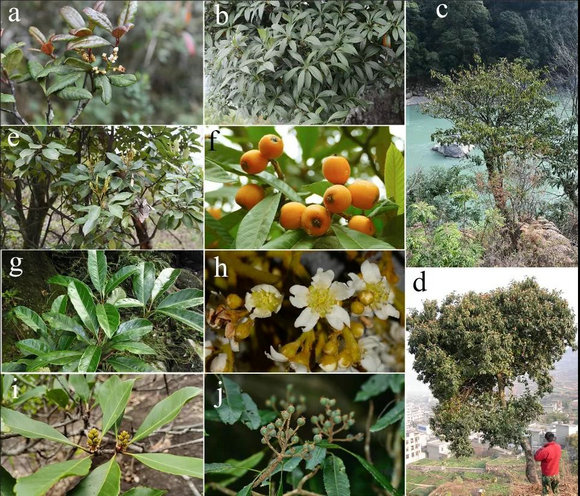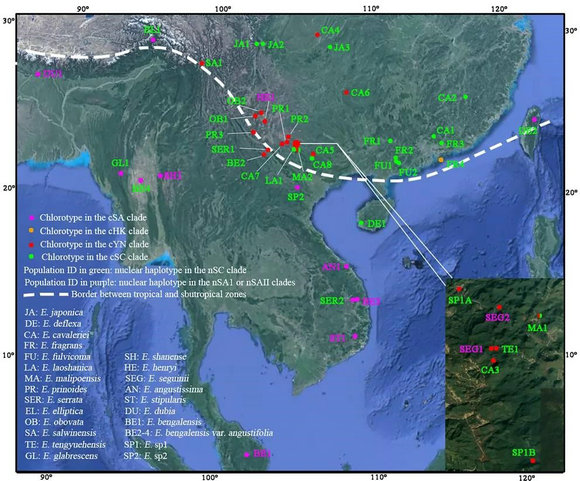The research group of Prof Wenbo Liao and Qiang Fan in School of Life Sciences demonstrated that trantitional area between tropical and subtropical zones could be a hotspot for hybridization taking Eriobotrya as example
Source: School of Life Sciences
Edited by: Zheng Longfei, Wang Dongmei
The continual global cooling from the late Miocene onwards caused the subtropical forests in Asia and border line between subtropical and tropical forests to migrate progressively southward, which could have created ample opportunities for hybridization between closely related species across the tropical and subtropical zones. Yet, very few studies have explored this possibility. The Yunnan-Guizhou Plateau (YGP) in Southwest China is a biodiversity hotspot for vascular plants, located in a transitional area between the floristic regions of tropical Southeast Asia and subtropical East Asia. The genus Eriobotrya (Rosaceae) comprises both tropical and subtropical taxa, with 12 species recorded in the YGP, making it a suitable basis for testing the hypothesis of between-biome hybridization.
Therefore, the researchers surveyed the evolutionary history of Eriobotrya by examining three chloroplast regions and five nuclear genes for 817 individuals (47 populations) of 23 Eriobotrya species (including 19 populations of 12 species in the YGP), plus genome re-sequencing of 33 representative samples. The authors concluded that: 1) phylogenetic positions for 16 species exhibited strong cyto-nuclear conflicts, most likely due to ancient hybridization; 2) the YGP is a hotspot for hybridization, with 11 species showing clear evidence of chloroplast capture; and 3) Eriobotrya likely originated in tropical Asia during the Eocene. From the Miocene onwards, the intensification of the Eastern Asia monsoon and global cooling may have shifted the tropical-subtropical boundary and caused secondary contact between species, thus providing ample opportunity for hybridization and diversification of Eriobotrya, especially in the YGP. This study highlights the significant role that paleo-climate changes likely played in driving hybridization and generating rich species diversity in climate transition zones.

Figure 1 The studied species Eriobotrya. a. E. seguinii; b. E. henryi; c. E. salwinensis; d. E. prinoides; e. E. obovata; f. E. japonica; g. E. malipoensis; h. E. cavaleriei; i. E. fragrans; j. E. deflexa. Photo of E. japonica was taken by Shaoping Chen, E. deflexa was taken by Mutan Hsieh, and others by Q. Fan.

Figure 2 Map depicting the distribution of 47 sampled populations of Eriobotrya, four clades of chloroplast haplotypes (cSA, cYN, cSC and cHK), and three clades of nuclear haplotypes (nSAI, nSAII and nSC). The border line between tropical and subtropical zones was drawn according to Institute of Geography & Chinese Academy of Sciences (1959).
These findings were published online in Molecular Ecology with the title “When tropical and subtropical congeners met: Multiple ancient hybridization events within Eriobotrya in the Yunnan-Guizhou Plateau, a tropical-subtropical transition area in China”, with Wenbo Liao and Qiang Fan in Sun Yat-sen University, Mao Kangshan in Sichuan University, and Ma Yongpeng in Kunming Institute of Botany as co-corresponding authors, Sufang Chen in Sun Yat-sen University, Richard Milne in University of Edinburgh, and Renchao Zhou as the co-first authors. Sun Yat-sen Univeristy is the first organization to complete the research. This work was supported by the National Natural Science Foundation of China (31800175 and 31670189), 2021 Guangdong Special Fund for Natural Resources Management and Ecological Forestry Construction (2021GJGY001), the Guangzhou Science and Technology Program (201903010076).
Link to the paper: https://onlinelibrary.wiley.com/doi/abs/10.1111/mec.16325
